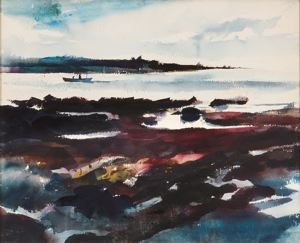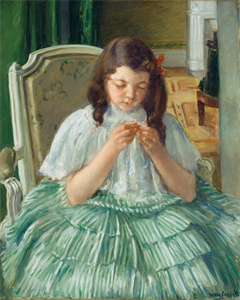Object Results
| Showing 1 of 1 |
|

Andrew Wyeth
American, 1917–2009
All of Andrew Wyeth’s subject matter for his paintings comes from Cushing, Maine or Chadds Ford; the two places where he has spent his entire life. His early career consisted of bold, impressionistic, wet on wet watercolors of the Maine landscape around the Wyeths’ summer home in Cushing, Maine. Lobstermen, Late Afternoon (1938) exemplifies this early “blue sky period of brash watercolors with deep, almost exaggerated tones.” He painted these Maine seascapes, filled with rocks, distant islands, and lobster studies, “with a kind of explosive impressionism…they are full of the exuberance of life and joy in the out-of-doors.” These watercolors brought Wyeth his first taste of critical success in 1937, when he exhibited a collection of his Maine landscapes in the William Macbeth Gallery in New York. This first exhibition sold out in one day, and critics praised Wyeth as “a watercolorist of quite exceptional ability”, claiming that “his work inevitably challenges comparison with that of our greatest in his field––men like Winslow Homer.” Wyeth did admit that Homer’s work served as a powerful, direct inspiration for his early watercolors, claiming that the American master’s influence “came in the ‘back door,’ kinetically, swiftly, naturally, almost the way a dry sponge soaks up the smallest drop of moisture.”
Lobstermen, Late Afternoon was painted for his second watercolor exhibition at the Macbeth Gallery in 1939, which was equally successful and quickly followed by a third show in 1941.
American, 1917–2009
Lobstermen, Late Afternoon
1938
Object Type:
Painting
Creation Place:
North America, American, Maine
Dimensions:
17 7/16 in. x 21 5/8 in. (44.29 cm x 54.93 cm)
Medium and Support:
Watercolor on paper
Accession Number:
1970.0005
Credit Line:
Gift of Mrs. Julian Wiener, Mrs. Stanley Newhouse, and James Loeb in honor of their father, Lucien S. Loeb
Copyright:
© The Estate of Andrew Wyeth / Artists Rights Society (ARS), New York
All of Andrew Wyeth’s subject matter for his paintings comes from Cushing, Maine or Chadds Ford; the two places where he has spent his entire life. His early career consisted of bold, impressionistic, wet on wet watercolors of the Maine landscape around the Wyeths’ summer home in Cushing, Maine. Lobstermen, Late Afternoon (1938) exemplifies this early “blue sky period of brash watercolors with deep, almost exaggerated tones.” He painted these Maine seascapes, filled with rocks, distant islands, and lobster studies, “with a kind of explosive impressionism…they are full of the exuberance of life and joy in the out-of-doors.” These watercolors brought Wyeth his first taste of critical success in 1937, when he exhibited a collection of his Maine landscapes in the William Macbeth Gallery in New York. This first exhibition sold out in one day, and critics praised Wyeth as “a watercolorist of quite exceptional ability”, claiming that “his work inevitably challenges comparison with that of our greatest in his field––men like Winslow Homer.” Wyeth did admit that Homer’s work served as a powerful, direct inspiration for his early watercolors, claiming that the American master’s influence “came in the ‘back door,’ kinetically, swiftly, naturally, almost the way a dry sponge soaks up the smallest drop of moisture.”
Lobstermen, Late Afternoon was painted for his second watercolor exhibition at the Macbeth Gallery in 1939, which was equally successful and quickly followed by a third show in 1941.
Keywords
Click a term to view the records with the same keyword
Portfolio List
Click a portfolio name to view all the objects in that portfolio
This object is a member of the following portfolios:
Your current search criteria is: Keyword is "MR" and [Object]Display Artist is "Andrew Wyeth".
